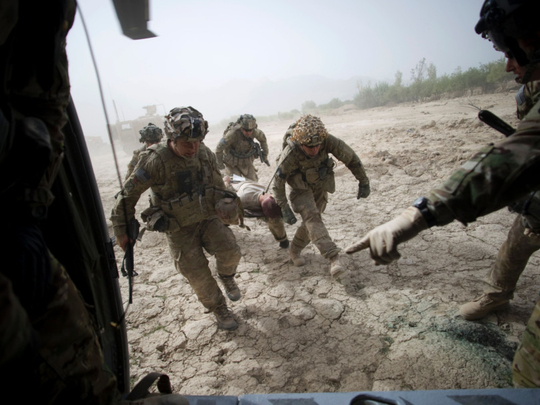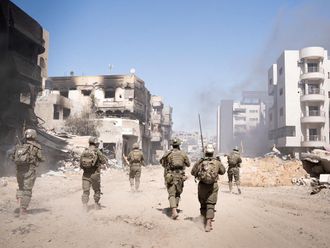
The next president of the United States, whether it is Democratic Hillary Clinton or Republican Donald Trump, will have to decide what to do about the war in Afghanistan. The longest and costliest war in US history was started by former president George W. Bush on October 7, 2001, and inherited in 2009 by a reluctant President Barack Obama, who, despite his wish, couldn’t end it after serving two four-year terms in office.
Afghanistan has long overtaken Vietnam as the longest US military intervention in the world. The US media has been reporting that it is also the most costly now at more than $100 billion (Dh367.8 billion). The costs have come down post-2014 with the drawdown of US-led Nato forces, but Washington and its allies will still need to pay for maintaining a smaller military presence and bankrolling the Afghan security forces until 2020 with yearly assistance of more than $5 billion.
A number of recent events highlighted the continued international interest in Afghanistan despite the apparently endless nature of the Afghan conflict and the distraction caused by conflicts elsewhere in the world, particularly in the Middle East. A conference in Brussels jointly hosted by Afghanistan and the European Union on October 4-5 and attended by 75 countries and 26 international organisations and agencies, received pledges of $15.2 billion in financial aid for the war-ravaged country over the next five years. The financial commitments surprised many as there had been talk of donor fatigue and attention shifting away from Afghanistan to conflicts in Syria and Iraq and the worst migration crisis since the Second World War. Besides, donors were generally concerned about the lack of transparency in using their funds primarily due to the high levels of corruption that prompted the Berlin-based Transparency International to categorise Afghanistan as the third most corrupt country in the world. On the political front also, the Afghan unity government has been slow to bring electoral reforms, hold the long-delayed parliamentary elections, stabilise the economy and give hope to the people.
Around the time of the Brussels conference, the participants were reminded about the volatile situation in Afghanistan as the Taliban launched a ferocious attack on Kunduz city exactly a year after having captured and held it for about two weeks. Taliban fighters were able to breach the defences of Afghanistan’s sixth largest city with a population of more than 300,000 and occupy important government buildings for 10 days, before being pushed out. The fall of Kunduz city, the capital of Kunduz province on the border with Tajikistan, not only caused casualties and displaced a large number of residents, but also embarrassed the Afghan government that had declared last year that Kunduz would never fall again.
As if reminding those attending the Brussels conference of their strength, the Taliban also launched attacks on provincial capitals in southwestern Afghanistan and on towns in the north. Taliban fighters entered Lashkargah, capital of poppy-rich Helmand province, fought for Tarinkot, the main city in Urozgan, and Farah, capital of Farah province. They overran the Ghormach district in Faryab province on the border with Turkmenistan and forced the country’s Vice-President General Abdul Rasheed Dostum, a former Uzbek warlord, to mobilise his now disbanded militia to join the Afghan security forces to undertake his third anti-Taliban military campaign to secure towns in his strongholds of Faryab, Jauzjan and Saripul provinces. Though now evicted from some of these places, the Taliban continue to maintain a strong presence outside Kunduz, Farah, Lashkargah, Tarinkot and Maimana and could mount more such offensives in the future. However, it is also true that Taliban may be able to capture, but unable to hold big urban centres.
The Taliban managed to gradually extend control over territory by nearly five per cent since the beginning of 2016, as reported by the Special Inspector General for Afghanistan Reconstruction (Sigar). Based on data provided by the US forces in Afghanistan, its report said the area under Afghan government’s “control or influence” decreased to 65.6 per cent by the end of May 2016 from 70.5 per cent last year. This meant loss of another 19 mostly rural districts to the Taliban, who now “control or influence” nearly 35 per cent of Afghanistan’s territory. This meant more violence as the fighting spread to 31 out of Afghanistan’s 34 provinces and a record 5,100 civilian casualties, including 1,600 deaths, were reported by the United Nations in the first half of this year.
The US invaded Afghanistan to destroy Al Qaida for plotting the 9/11 attacks, using Taliban-ruled Afghanistan’s soil and topple the Taliban regime for harbouring Osama Bin Laden. It managed to oust Taliban ruler Mullah Mohammad Omar by the end of November 2001 and dealt heavy blows to Al Qaida to pave the way for installation of the pro-West government headed by former president Hamid Karzai. The total fatalities suffered by US-led foreign forces till 2015 were 3,500 soldiers only, but the transition of security to the Afghan government post-2014 caused a rapid rise in casualties of Afghan soldiers and reached a record level of 7,000 deaths and 12,000 wounded in 2015. The US military termed these casualties as unsustainable in the long term.
With US military officials describing the situation in Afghanistan as a “stalemate” and the peace process initiated by President Ashraf Gani going nowhere, due to the inflexible Taliban position, there isn’t much optimism that the Afghan conflict could be brought to an end soon. Gani did manage to make peace with former Mujahideen warlord Gulbuddin Hekmatyar, but it won’t alter the military situation as he lacks fighters. As relations reached a new low with Pakistan — the key country with some influence on the Taliban in the four-country, peacemaking Quadrilateral Coordination Group — it has no real incentive to help Gani stabilise Afghanistan.
Rahimullah Yusufzai is a senior journalist based in Peshawar.










